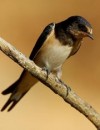 Nuclear accidents can have devastating consequences for the people and animals living in the vicinity of the damaged power plants, but they also give researchers a unique opportunity to study the effects of radiation on populations that would be impossible to recreate in the lab.
Nuclear accidents can have devastating consequences for the people and animals living in the vicinity of the damaged power plants, but they also give researchers a unique opportunity to study the effects of radiation on populations that would be impossible to recreate in the lab.
Tim Mousseau, who directs the Chernobyl Research Initiative at the University of South Carolina in Columbia, together with an international team, is studying the long-term ecological and health consequences of the 1986 accident at the Chernobyl nuclear power plant in the Ukraine. Mousseau has been studying Chernobyl since 1998 and his latest work, carried out with colleagues in France and published in Oecologia last month, finds that bird species with orange feathers living in the fallout zone seem to be more susceptible to radiation than their drabber gray and black fellows. They suggest that production of the more colourful pigments consumes antioxidant molecules that would otherwise confer protection against radiation damage, and that this molecular trade-off is shaping bird populations around the former nuclear power plant.
Counting birds
One of the team, Anders Møller from the Pierre and Marie Curie University in Paris, donned a radiation-protection suit to make four bird-watching trips between 2006 and 2009 to the Red Forest and other locations around Chernobyl. In a 2007 analysis of the data from the first bird counts made in spring 2006, Mousseau and Møller found that birds whose feathers were coloured with bright yellow and red carotenoid-based pigments showed a decline in abundance as radiation levels increased, though there was no comparable correlation for bird species with melanin-based colouring, such as brown, black and reddish-brown2. The new study takes the analysis a step further by teasing out the different protective effects of different types of melanin pigment.
“Other people had looked at melanins in fungus near Chernobyl. Eumelanin helps defend fungus,” says Ismael Galván, a biologist at the University of Paris-Sud and a contributor to the new study along with Mousseau and Møller. But another type of melanin, phaeomelanin, is a lighter red pigment; it’s what gives redheads their hair colour and Red Forest birds such as the hoopoe (Upupa epops) their distinctive palette of light browns and their orange crown feathers.
Cost of colour
Such elegant orange shades may attract mates or help the birds blend in to their environment, but they have a chemical cost. Making phaeomelanin consumes large amounts of a tripeptide called glutathione (GSH) which is an antioxidant molecule that can also protect tissues from radiation damage by mopping up free radicals. Glutathione is not needed to make eumelanin. So the team decided to compare the effects of the presence of eumelanin or phaeomelanin pigments on the distribution and abundance of bird species in the Red Forest. Producing too much phaeomelanin, Galván hypothesized, would use up a bird’s stocks of GSH, making it more susceptible to radiation.
The researchers reanalysed the survey data on 97 bird species in search of differences between orange-brown birds, assigned a phaeomelanin score from 0 to 5 depending on the intensity and extent of the colours, and grey or black birds, to which they assigned a eumelanin score. Eumelanin levels, it turned out, had no correlation with bird abundance in relation to background radiation, but birds with relatively high levels of phaeomelanin became rarer as radiation levels increased.
Biologist Kevin McGraw of Arizona State University in Tempe says that pigments are good ecological tools: “these colours are real-life indicators of population viability and individual health. If we can amass long-term data sets before these disasters we can get a sense of the changes that occur due to humans.”
Nevertheless, he and other biologists have argued for years that scoring bird pigments by eye is not as persuasive as a chemical analysis, but that the size of the study makes that difficult: “It’d be real tough to ask them to do intense pigment sampling for 97 species.”
But Galván and his colleagues are aiming to do just that — last summer they collected blood samples to quantify antioxidant and pigment levels.
Mousseau is now in talks with Japanese colleagues to plan studies there following the disaster at the Fukushima nuclear power plant. Yukie Kajita, an entomologist at the University of Kentucky in Lexington, whose hometown of Koriyama is near Fukushima, says that although the radioactive elements released at Fukushima are different from those released at Chernobyl, researchers will want to design studies there as soon as practical.
“The biggest question is whether or not these observations will let us make predictions for other radioactive areas in the world,” says Mousseau.
See this news story as it appeared on Nature News [html] or here [pdf]
Update: Scientific American also picked up the story here: [html]
& the story is available in Spanish: [html]